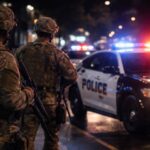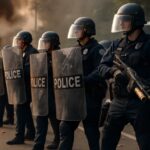Even in the best of circumstances, police departments often find themselves trying to do more with less. And every time we get updated crime statistics, we also receive a new opportunity to test what works best.
We should never forget, however, that any new policing experiments put people’s lives on the line – both the officers in charge of law enforcement and the families who may end up victimized by criminals. And yet, politicians often make these decisions based on electoral trends or fashionable ideologies.
This is why we are so excited to see cold, hard data regarding policing strategies to reduce crime. Evidence-based research can help us implement better policies that will safeguard officers and families alike.
What Can We Do To Reduce Crime?
Many studies have attempted to predict which measures are more effective to reduce crime rates in general, and especially violent crime. Often, the answer appears simple: adding extra officers should make police departments more effective. Meanwhile, spending more money on social services, sensitivity training, and community subsidies sometimes makes sense on paper but often fails to deliver safer cities.

Many studies have tried to correlate these factors with crime rates in major cities across the country. In many cases, the studies came back inconclusive: they didn’t point out a consistent relationship between these measures and a reduction in crime rates.
So far, the most impactful study may not be new, but it has resisted the test of time. It was published in the Police Journal back in 1985. Instead of simple numbers, researchers looked at whether any patrols implemented were highly visible.
What Does the Study Show Us?
As part of what Criminal Justice now considers its “gold standard,” this study measures the effectiveness of visible police patrols using two variables: their effect on crime deterrence and their ability to detect and arrest criminals.
For the purpose of this study, low-visibility patrols included mixed teams, using officers in plain clothes, and strategic “stop points” that cannot be identified from a distance. Meanwhile, high visibility approaches included visible vehicle stops and stakeouts.
When it comes to preventing an immediate outbreak of crime (crime deterrence), researchers found that the best results came from highly-visible exercises, especially at night. When police patrols are visible, and police officers remain approachable and available at all times, they were better at keeping crime away.
And yet, police cannot reasonably be present at all times and under all circumstances. Equally important is the ability to catch criminals in the act, or when they’re about to commit a crime. When identified, police officers should be able to identify and arrest criminals promptly. For this, the study suggested that a combination of high and low-visibility patrols was better.
Final Thoughts
The bottom line? It’s rarely an issue of numbers. In many cases, using your existing officers efficiently, and ensuring they have the tools they need – whether that means training, equipment, or support from other teams – is more important than throwing bodies at the problem. Politicians should be aware of this when announcing their crime-fighting initiatives, rather than suggesting flashier options like increased recruitment or defunding initiatives.








